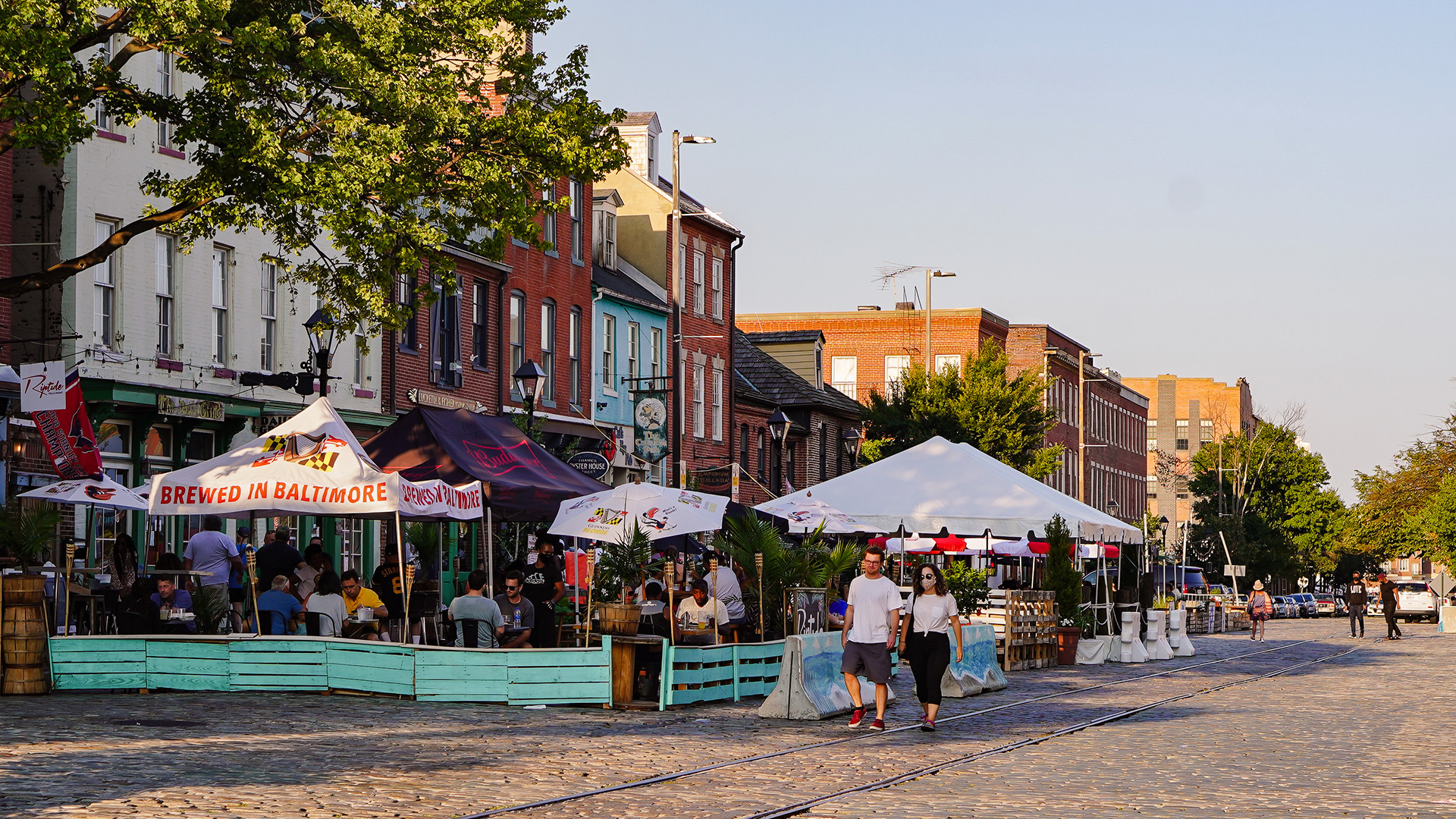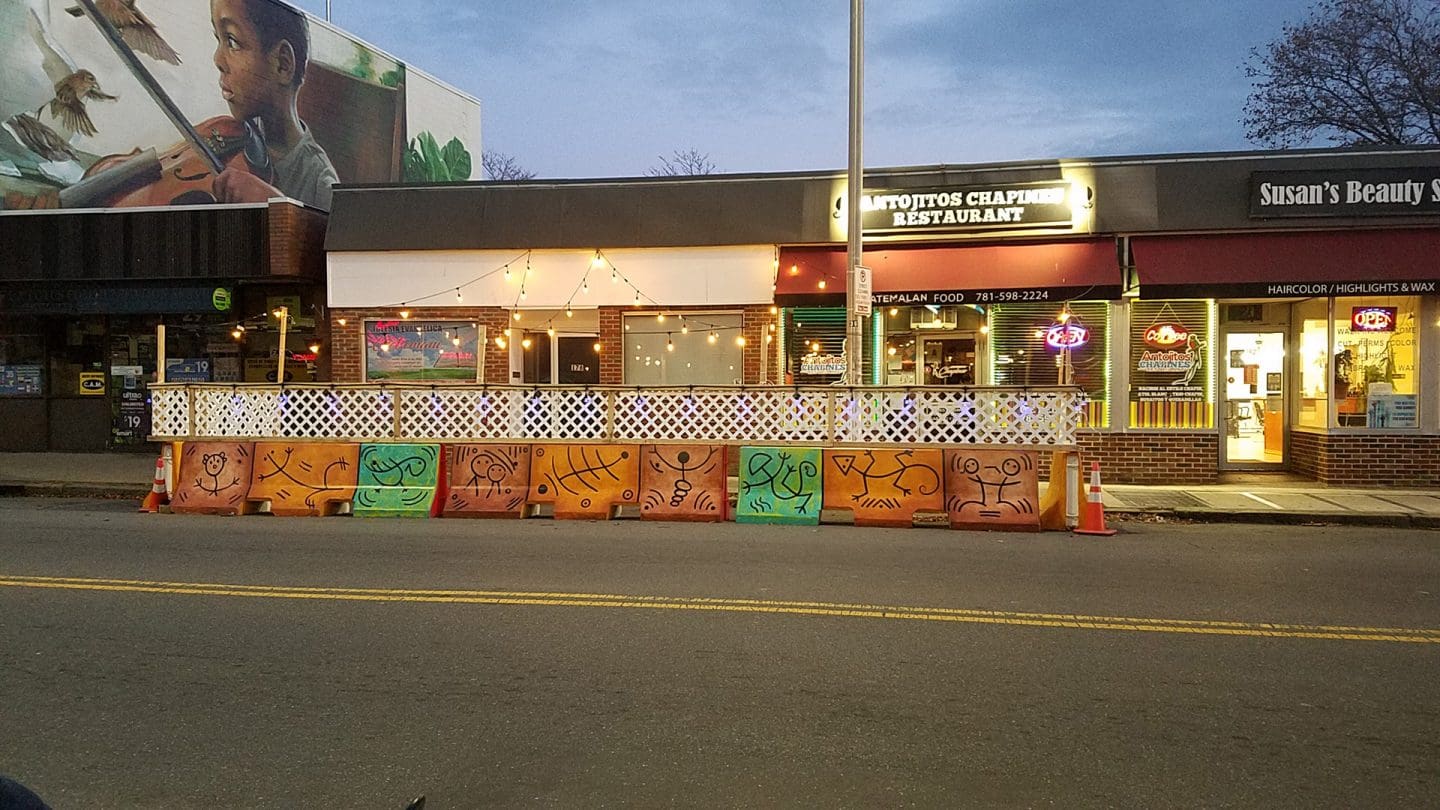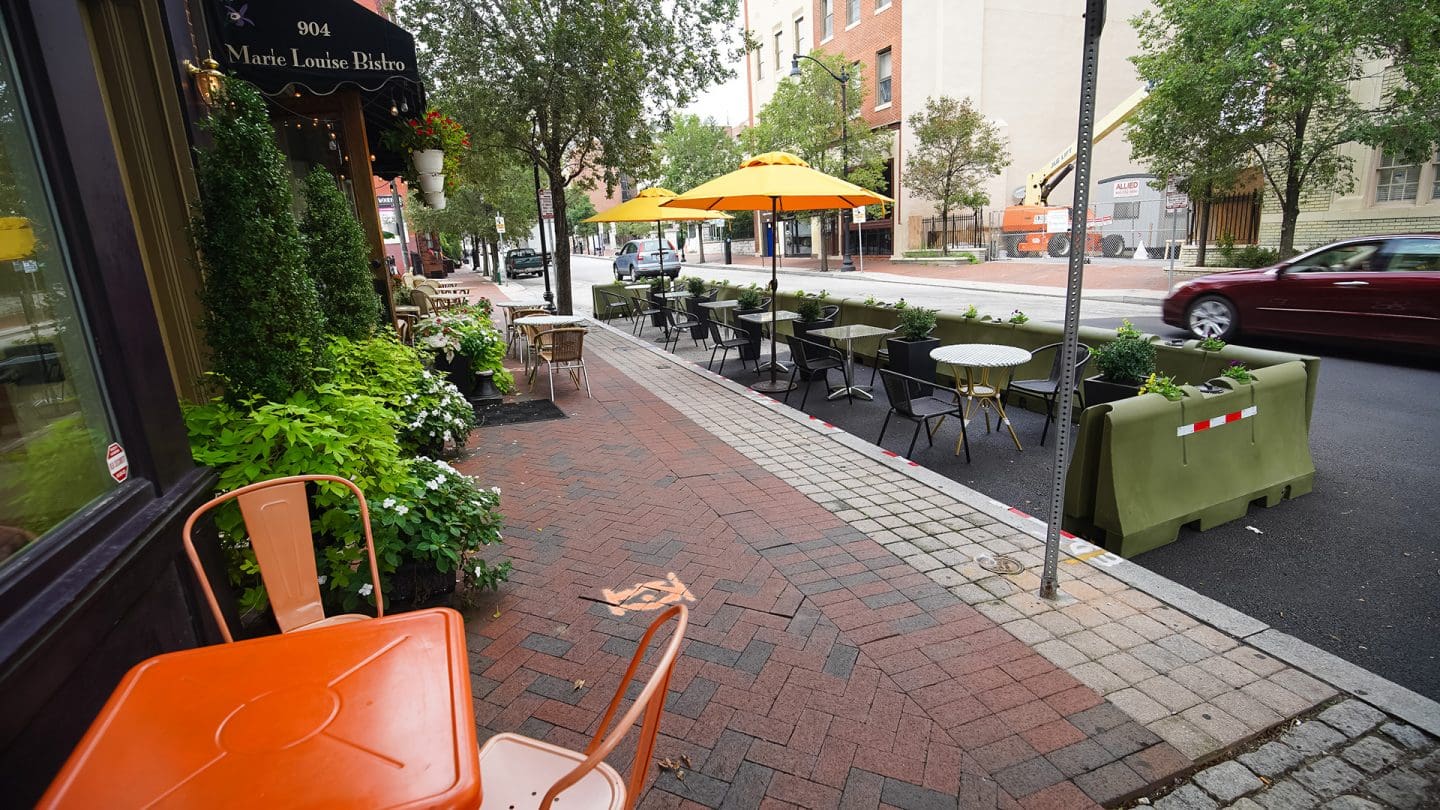April 7, 2021
Quick build projects, such as parklets, outdoor dining installations, and shared streets, blossomed across the country in spring and summer 2020 due to COVID-19. Over the months, cities have converted tactical materials such as cones and barrels to more durable materials, causing many to conjecture that we have hit a pivot point in the way we design and use our streets.
Senior Engineer/Planner Alek Pochowski, Planner Margaret Kent, Principal Engineer Wade Walker, and Associate Planner Amanda Leahy say the impact to transportation engineering and planning projects could go a step further. The pandemic may also be an inflection point in the speed of transportation project delivery.

What We’ve Learned from Quick-Build Installations During COVID-19
In the early days of COVID-19, cities needed to quickly respond to social distancing requirements and offer space for safer recreation and dining on their streets. Many cities waived permitting fees and applications to allow restaurants and retail businesses to expand their business footprint onto the public right-of-way or into privately owned parking facilities, and closed streets to through traffic to support pedestrian and bicycle activity.
If quick build (also referred to as tactical urbanism) is a short-term demonstration to demonstrate long-term possibilities, what have quick build projects during the pandemic demonstrated?
For one thing, the number of people walking, running, and eating in the streets points to the demand for space for active transportation and socialization. When provided the space, people have used it, in a variety of ways. The pandemic has shown us what our streets could look like when they’re designed for people, not cars.
“In the early days of the pandemic, it was so glaring when we had packed sidewalks but the streets were completely quiet,” said Alek Pochowski. “It has drawn to light how much space we provide cars and how little space we provide humans.”
Margaret Kent noted that successful quick build projects have leveraged the input and creativity of residents, from proposing project locations to helping paint and implement projects.
“I know some municipalities had a program where they asked residents to submit ideas of what they wanted to see built, and they got responses, and so they were able to implement based on that. These grassroots initiatives can be more successful than municipalities deciding where to install projects. It also showed that residents are creative; they do have ideas,” she said.
“A lot of these conversations were going on before COVID-19,” said Wade Walker. “But the pandemic is a pivot point that is going to influence the way we think about street design. We all agree things will be different, but we don’t yet know how. This is an inflection point.”

Lynn, Massachusetts

Baltimore, Maryland
The Case For Quicker Project Implementation
While quick build can refer to materials-such as temporary street closures and outdoor dining installations-it can also refer to accelerated project delivery, and this is where we may see an additional shift in transportation thinking.
Quick build has been around long before COVID-19. Wade, who joined Kittelson’s Orlando office in mid-2020, described several impactful quick build projects he was involved in years before the pandemic. One of these projects used house paint to create a two-way cycle track that has since been constructed as the first fully separated two-way cycle track in the state of Tennessee. Another project is transforming an entire district of a city in conjunction with scheduled resurfacing. Quick build elements are added that include delineating street space for curb extensions, furnishing zones and outdoor dining, on street parking, and bike lanes using pavement applications, planters, traffic domes, and public art, effectively rebalancing a street without physically reconstructing it. While the enhancements were originally meant to be temporary, the community has embraced its artsy feel and prefers to keep it as-is. The project cost around 20% of reconstructing the street, a stark comparison to what it would have cost through traditional design and reconstruction methods.
In the past year, the pandemic has moved quick build to the forefront of the transportation conversation. The process has revealed on a large scale what many have been arguing to be substantial benefits of quick build, including more substantial community engagement and the courage to test out new and imaginative ideas. As urban researcher Helen Rowe put it: “Street experiments help cities work with, not against, some people’s tendency to dislike change.”
Quick build gives cities and residents the ability to try something new without fully committing. And ultimately, it can transform a street on a short timeline.
“It has shown us that we can move more quickly,” said Amanda Leahy. “Having been a planner for over a decade, I know firsthand how slowly the path to implementation can be. Quick build projects allow for rapid implementation and iteration that is informed by user experience. These types of projects are an opportunity to involve community and build capacity for change .”
So, Is Quick-Build the Future of Transportation Planning?
It is important to note that quick build comes with tradeoffs, such as the likelihood of missing design details from moving too quickly.
“It all comes back to liability,” said Alek. “That’s why we see concrete barriers for these streateries instead of cones.”
However, the pandemic provides an opportunity to consider how projects can be implemented more flexibly. For many cities, COVID-19 was a crash course in tactical urbanism, removing barriers and increasing an appetite for lower scale interventions to experiment with different approaches to placemaking and reallocating street space.
“I argue we need to move with more urgency and speed. We need to assess how we can lower barriers to implementation and build quickly,” said Amanda. “The pandemic and other factors do need to be a changing point in how we operate. There is something in this moment that is important for us to capitalize on.”
"The pandemic and other factors do need to be a changing point in how we operate. There is something in this moment that is important for us to capitalize on."
- Amanda Leahy, Associate Planner
Centering Equity in Quick Build
Even with the uptick in conversation surrounding equity in transportation, Alek and Amanda noted that the approach to many quick build projects in the last year raises some equity flags.
“To be candid, within some cities, there are different tactical urbanism approaches being taken in different neighborhoods,” said Alek. “They will allow and use different materials in different neighborhoods because of who is living there. There needs to be more of an equity component built into this.”
How can cities center equity as they increase the speed of project delivery, both during COVID-19 and in the future?
“We continue to see that agency staff developing relationships is key in order to engage and involve people, know where to post information, establish a more trust-based relationship,” said Amanda. “When there is more community buy-in and support, that makes it easier to go in later with other projects down the line.”
Margaret noted that there is tremendous opportunity for agency staff to widen the group of people with whom they collaborate in their own agency/municipality.
“Reach out to folks in your agency who might have community relationships from a different discipline, such as housing,” she said.
The City of Oakland, CA is setting an example through the way they are adapting their Slow Streets program. While the program has been acclaimed by other cities for the closure of more than 21 street miles for physically distant walking, biking and rolling, it also received feedback that the first phase did not equitably meet the needs of residents. In response, the City is surveying residents and businesses along each Slow Street, reaching out to corridors in order of priority level as defined by the Geographic Equity Toolbox. Based on the feedback, they will upgrade materials to be more durable, make other changes needed, or remove the Slow Street. The City is pausing further roll-out of the program until this evaluation is complete, setting a laudable example of what it means to listen to community members and make equity a priority.
Conclusion: Is Any Transportation Project Truly Permanent?
In making the distinction between tactical urbanism and permanent projects, it’s important to note that every city, neighborhood, and street is an evolving story. No matter the speed of implementation or permanency of materials used, with every project, the best thing municipalities can do is consider the holistic vision for that particular location. Tactical urbanism and quick build are not band aids over specific issues. They’re a demonstration of possibilities for how that street can serve its community differently.
When agencies approach projects this way with a community-based mindset, they’re laying the foundation for meaningful change to occur in projects of all shapes and sizes.
At Kittelson, we’ve been excited to support agencies in pivoting to meet their communities’ needs during a unique year. Recently, we’ve been providing technical support to municipalities throughout Massachusetts who have been implementing quick build bike facilities, expanded pedestrian space for social distancing, traffic calming, shared streets, parklets, and streateries through the MassDOT Shared Streets and Spaces grant program; our technical assistance is funded by the Barr Foundation and the Solomon Foundation. We’d be happy to share what we’re learning on this project or further discuss any of the concepts in this article. Feel free to reach out to Amanda, Wade, Margaret, or Alek to continue the conversation!
